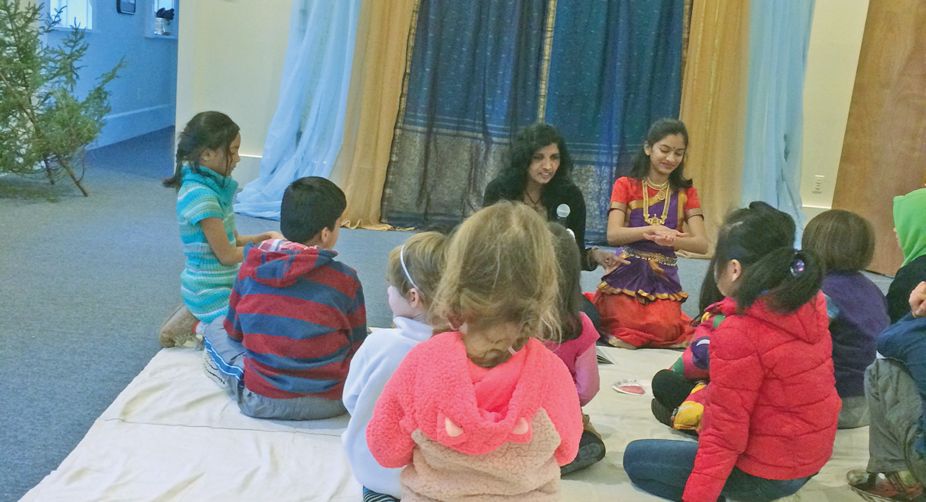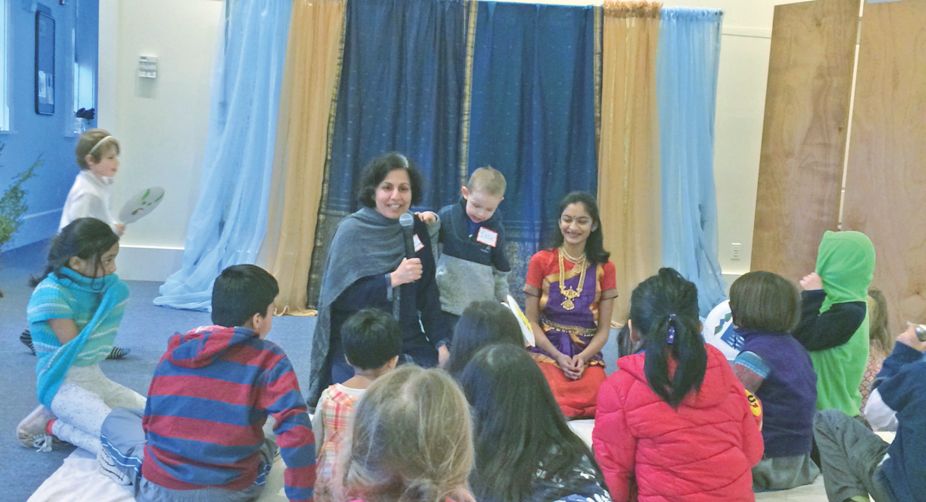Indian stakes in White House race
The Indian-origin candidates have many hurdles to cross, even to get their respective party's nomination in the primary in which the Whites dominate.
The Indian Americans of Lexington settled in Massachusetts showcase an eclectic mix reflecting the adaptation of western life with their own traditions.

A Retelling of Tales from the Panchatantra
‘They are a very organised group,” says the lady about Lexington’s Indian Americans. “They have their own website and newsletter.” “Lexington is where the first battle of the American Revolution took place, and at that time, most of the people in this town were of West European origin. What is it like to have people of Asian origin in your midst?” I ask her.
“Well, over the years, people from different countries have made Lexington their home. First came the British, then the Scots, and then the Germans and the Dutch. The Italians came in the 1800s, as did the Irish. So we’ve had people from different backgrounds. What attracts people of Indian origin is that this state values education and scientific research. Its medical centers encourage medical research and offer employment.”
Advertisement
We are in the Lexington Historical Society where a cultural event, a retelling of Indian and Western folktales, is about to begin. The programme starts with a beautifully rendered Ganesh Stotram by 13-year-old Shireen Kumar.
Advertisement
It is particularly impressive when a dancer brought up outside India can express nuances that are typically Indian. I later learn that Kumar’s guru, Bala Rajamani, had been the featured artiste, but a couple of hours before the programme was due to start, an emergency occurred in her family. So, 13-year-old Kumar was asked to give the opening performance.
Kumar finishes dancing and asks the audience to guess what the different mudras mean. The children who are sitting in the front copy the different elephant mudras and I can see that they are having a good time.
Then the interactive storytelling begins. A member of the Indian American Organisation narrates two tales from the Panchatantra, and the young audience members are invited to act out some of the roles. After that, a member of the Historical Society(who is also a re-enactment actor) dressed in a costume from colonial times, narrates a couple of tales from Aesop, some of which are very much like those from the Panchatantra. I get the feeling that this choice of stories is no coincidence.

Neerja Bajaj, co-president of the Organisation of Indian Americans of Lexington, has been a resident of this town for 14 years. “We have three main objectives,” she says. “To create a cultural community where Indians can come together to celebrate their festivals; to make a contribution in the local government of Lexington and to encourage a spirit of volunteering on town committees.”
These objectives are also stated in the website of the organisation
(indianamericansoflexington.org). “IAL aims to foster participation and engagement of its members in various social, multi-cultural, educational, town/civic and charitable activities through collaborative events.”
Asians make up about 20 per cent of Lexington’s population. Of this number, about 50 per cent is of Chinese origin, and about 25 per cent of Indian descent. About 31 per cent of the town’s school children are Asian. But till recently, only about three per cent of Lexington’s elected positions were held by Asians.
The town of Lexington conducted a study on how to get more Asian involved in town governance, and found the reasons why the number was so low. The average age of Lexington’s Asians is seven years younger than that of other residents. So Asian adults are busy taking care of school-going children. Also, though younger Asians speak English, many older Asians do not.
This drawback, added to the one that volunteering in local government committees is not part of most Asian traditions, makes it difficult for them to take part in town affairs.
So this is the backdrop against which Lexington’s Indian Americans are trying to get more of their people involved in the government of their town.
“One of our missions is to educate Indian Americans on how this town runs. Only a small percentage of them were born here, and in India the government operates in a different way. In Lexington, it runs because of volunteers. So we invite town officials to talk about how decisions (in local government) are made,” Bajaj tells me.
Local government in Lexington is unique in many ways. An elected five-member Board of Selectmen makes the policies and oversees town government, which is provided by a professional town manager whom the Selectmen appoint.
The legislative function is performed by about 200 elected members called Town Meeting Members, and committees formed by unpaid volunteers function in an advisory and oversight capacity to Town Meeting Members.
“In the recent March 2018 elections for Town Meeting Members, 11 Indian Americans ran for the elections,” says Bajaj. A note of pride enters her voice as she adds, “10 of them won! So 10 per cent of TMMs are of Indian origin though Indians account for about five per cent of the total population of Lexington. An Indian American is also a School Committee member.”

But what is more difficult is getting Indian Americans to volunteer for the committees. “The problem is for people to find the time,” says Bajaj. “Also, these are not positions to which one is elected. Volunteers work outside limelight. But (what is important is that) when you volunteer you create a community for your child. Your child sees you connected to the community and thus feels, ‘This is my home. I am comfortable here’. The good thing is that we do have volunteers on several committees and the number is going up every year.”
Bajaj is a volunteer at the Diversity Task Force Committee whose job is to suggest how Lexington can be a more inclusive town. Other Indian Americans volunteer on committees such as the School/ Education Committee, Youth Affairs Committee, Town Liaison & Community Outreach Committee and Technology and Publicity Committee.
When Bajaj adds the Library Committee to this list, I can’t help smiling. Earlier, when I visited the public library, I looked, as I usually do at any library, at the books on the American Civil War, and then proceeded to the 954 section for books on Indian History.
Four or five new titles caught my eye. I opened the books and found bookplates stating that they were gifts of the Indian American Community. Bajaj tells me that the Indian Americans on this committee have organised programmes on the meaning of Diwali, and on how to make rangolis and everyone made rangolis in front of the main library stairs.
Recently, Lexington also celebrated its 300th birthday, and Indian Americans were involved in many of the events. One was a dance programme where different communities taught people their traditional dances. It was so successful that it is held every year, and Indian Americans continue to take part in it.
Bajaj says that the town has created a support structure for new families. Indian Americans participate in this. They welcome new families and help them settle down. “We strive to act as a conduit between Indian Americans and the town,” she says.
Bajaj introduces me to Richard Pagett, President of the Lexington Historical Society. Pagett has served as a Selectman; he was also sent by Care to India for three years in the 70s’. All this makes him the right person to invite Asian Americans to participate in local government.
“Local government is heavily dependent on citizen participation,” he says. “We depend on citizen committees to set the agenda for all work. (At first,) as we became more and more diverse, our concern was that this kind of government would not survive if everybody did not participate in it”.
He understands that Asian Americans need to feel welcome to join in local government. He points out that in the half a dozen programmes that the Indian Americans have held with the Historical Society, the aim has been to show the similarities between the two traditions in dance styles, storytelling etc.

He makes special mention of a lecture by Mahatma Gandhi’s grandson, Rajmohan Gandhi that he attended, where Gandhi drew parallels between the American Civil War and the Indian War for Independence in 1857. (Gandhi’s book is entitled: A Tale of Two Revolts: India’s Mutiny and the American Civil War)
Pagett clearly feels great satisfaction in seeing children of Asian origin adopt American traditions as their own. He tells me about the summer camps on the American Revolutionary Wars for children, and is clearly proud of the fact that in a recent re-enactment, 25 per cent of the children in the Fife Drum Corp were of Asian origin. “So they are beginning to look upon this as their own tradition,” he says.
He is also pleased with the way Indian American participation in local government is increasing, and speaks about the recent election that have made Bajaj so happy. “The Indian Americans bring a refreshing new perspective on how things are run,” he says.
“We are so tradition-bound in local government. But they say, ‘Why does it have to be this way?’ and so (our) discussions are lively and that is very good for the town.” A blurb on the Indian American newsletter comes to mind as I think of what Bajaj and Pagett have told me: “This is your world. Shape it, or someone else will.” The Americans of Indian origin in Lexington are clearly taking it to heart.
The writer is a retired librarian. She lives in New Jersey
Advertisement